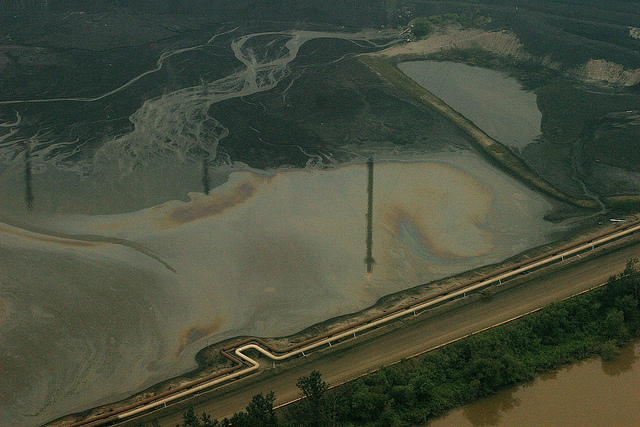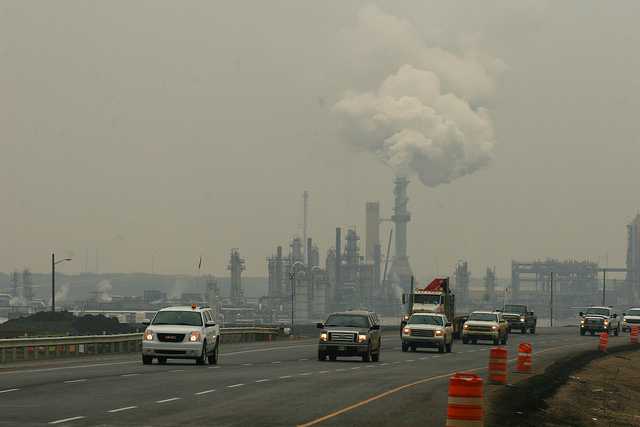|
| |
| 26. Februar 2014 |
Abwasser-Seen mit giftigen Rückständen aus der Teersande-Gewinnung
in Alberta verseuchen den Athabasca River |
| |
| Am 21. Februar 2014 meldete CBC News „Oilsands study confirms tailings found in ground water, river. Federal study shows water from tailing ponds leaking into Athabasca River.“ Was Umweltschutzgruppen wie das Pembina Institute und First Nations schon seit vielen Jahren dokumentieren und berichten, findet nun eine neuerliche Bestätigung von offizieller Regierungsseite. Richard A. Frank von Environment Canada (Water Science and Technology Directorate) und andere Wissenschaftler publizierten in Environmental Science and Technology ihre neuen Studienergebnisse (Profiling Oil Sands Mixtures from Industrial Developments and Natural Groundwaters for Source Identification. Frank, R.A. et al., Environmentel Sciene and Technology, Januar 2014). In den CBC News wurde gemeldet: „New federal research confirms that Alberta’s oilsands are polluting ground water and seeping into the Athabasca River. The industry has maintained that toxic chemicals are contained safely in tailing ponds, but new research shows this isn’t the case. ‚Well, it looks like what they’ve seen is that in fact the tailings ponds are leaking‘, said Bill Donahue, environmental scientist with the oilsands advisory committee. ‚They found also not only are those tailings ponds leaking, but it looks like it is flowing pretty much from those tailings ponds, through the ground and into the Athabasca River.‘ ‚So, there goes … that message we’ve been hearing about. ‚These tailings ponds are safe, they don’t leak’ and so on.‘ Previous studies using models have estimated the leakage at 6.5 million litres a day from a single pond. But the Environment Canada study used new technology to actually fingerprint the mix of groundwater chemicals in the area. It found the mix of chemicals from tailings is different from that in naturally occurring bitumen deposits. That tailings mix, which contains toxic chemicals, is found in groundwater around mining operations, but not in areas away from development. The Pembina Institute, an environmental research group, has long said the ponds leak. But analyst Erin Flanagan said the new research shows even Pembina underestimated how much. ‚As we continue to expand the industry, we’re also expanding the production of tailings waste.‘„ |
| |
 |
| Abwasser-See mit giftigen Förderrückständen |
© Julia Kilpatrick, The Pembina Institute,
Aufnahme vom 5. Juli 2013 |
|
| |
| Doch nicht nur von den Lecks in den Giftseen mit den Förderrückständen gehen Gefahren aus, auch die Luftverschmutzung durch den Teersande-Abbau und selbst die Verdunstung aus den Giftseen ist höchst bedenklich. „Tailing ponds are not the end of the journey for pollutants they contain. PAH [polycyclic aromatic hydrocarbons] are highly volatile, meaning they escape into the air much more than many people think“, erklärte Abha Parajulee, Autor einer Studie der University of Toronto. „Oilsands air pollutants underestimated, researchers find. University of Toronto study finds release of carcinogenic compounds greater than believed“, lautete die Schlagzeile eines Artikels über die Studie in den CBC News vom 3. Februar 2014. Die Studie von Abha Parajulee und Frank Wonia „Evaluating officially reported polycyclic aromatic hydrocarbon emissions in the Athabasca oilsands region with multimedia fate model“ wurde im Januar im Proceedings of the National Academy of Sciences/USA veröffentlicht. |
| „Oil field fumes so painful, Alberta family forced to move. Severe headaches, dizziness, rushes and loss of memory: all symptoms reported to a new hearing examining health effects of Alberta’s rapidly expanding heavy oil industry“, lautete ein Artikel von Mychaylo Prystupa am 26. Januar 2014 im Vancouver Observer. |
| Zwischenzeitlich klagen nicht nur viele Anwohner der Teersande-Abbaugebiete in Alberta über gesundheitliche Probleme, 17 First Nations-Gruppen in Alberta zogen mit Klagen gegen die Teersande-Industrie, die Provinz Alberta und die kanadische Regierung vor Gericht. „Alberta’s Oil Legacy: Bad Air and Rare Cancers. Sickening carcinogens now saturate the province’s Industrial Heartland, study finds“, schrieb Andrew Nikiforuk am 24. Oktober 2013 in The Tyee. „Recent research on the oil sands in Fort McMurray tells, as scientists put in ‚a consistent story of increased contaminants and ecological change‘ since bitumen production began in the late 1960s. In particular lake and river pollution is increasing; fish deformities are rising; mercury levels are increasing in birds; arsenic levels are increasing in groundwater; and the caribou population is nearing extinction. Elevated rates of blood, bile duct and lymphatic cancers have also been found 300 km downstream of the oil sands in the Dene, Metis and Cree Community of Fort Chipewyan. Almost everyone working in the bitumen mining boomtown of Fort McMurray knows someone who has had a brush with cancer.“ Isobel J. Simpson, eine der Autorinnen der Studie der University of California, Irvine und der University of Michigan (vgl. Meldung vom 2. Januar 2014 auf dieser Website) sagte: „We don’t want this to be study after study after study with no action. There’s enough here to recommend reducing carcinogens in the area.“ Mit bornierter Hartnäckigkeit verschließt sich die Provinzregierung von Alberta nach wie vor allen wissenschaftlichen Erkenntnissen über die Gefährdung von Mensch und Umwelt durch den Teersande-Abbau. Die Petro-Dollars sind der Provinzregierung wichtiger als die Gesundheit der Bevölkerung. Nikki Booth, Sprecherin des Alberta Environment and Sustainable Resource Development, erklärte deshalb ganz im Dienste der Interessen der Ölindustrie: „Based on the results of our monitoring, we see no evidence to suggest that people in the Industrial Heartland region are exposed to levels of chemicals indicated in the paper.“ |
| |
 |
Die alltägliche Luftverschmutzung
in den Teersande-Abbaugebieten |
© Julia Kilpatrick, The Pembina Institute,
Aufnahme vom 5. Juli 2013 |
|
| |
| Wie ernst die Umweltprobleme in den Teersande-Abbaugebieten Albertas sind und wie stark die First Nations in Fort MacKay am Athabasca River nördlich von Fort McMurray und in Fort Chipewyan am Lake Athabasca betroffen sind, zeigt der Film „Das Geschäft mit dem Öl aus Sand“ von S. Mesquida, G. Corgnet und Y. Le Gléau (Arte G.E.I.E. What’s Up Productions, 2013). Diese sehenswerte und informative Reportage lief am 01.12.2013 aus Arte. Sie finden sie unter folgendem Link: www.youtube.com/watch?v=vO-AmVSqET0 |
| |
 zurück zurück |
|
|

